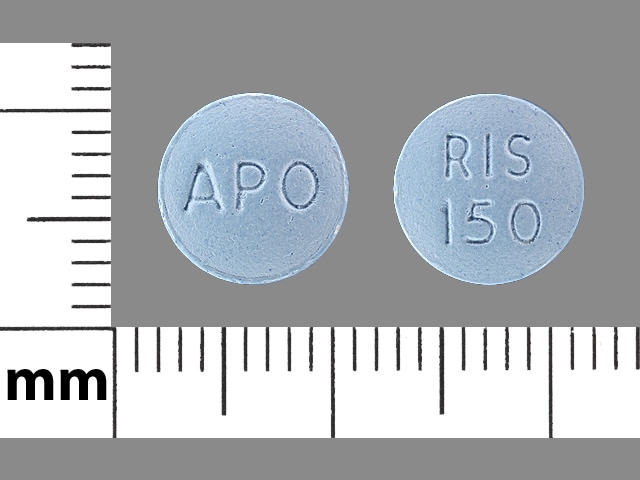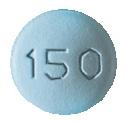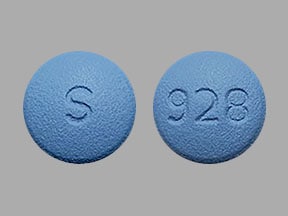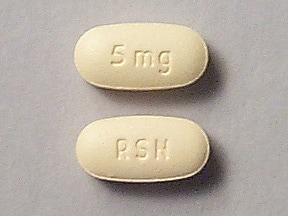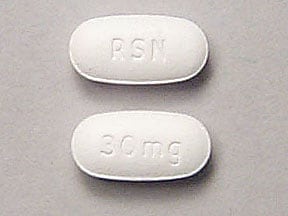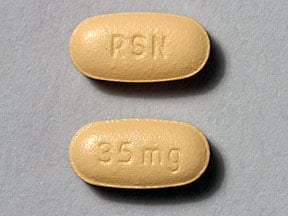Dosage Forms
Excipient information presented when available (limited, particularly for generics); consult specific product labeling.
Tablet, Oral, as sodium:
Actonel: 5 mg, 30 mg, 35 mg
Actonel: 150 mg [contains fd&c blue #2 aluminum lake]
Generic: 5 mg, 30 mg, 35 mg, 150 mg
Tablet Delayed Release, Oral, as sodium:
Atelvia: 35 mg [contains edetate disodium]
Generic: 35 mg
Pharmacology
Mechanism of Action
A bisphosphonate which inhibits bone resorption via actions on osteoclasts or on osteoclast precursors; decreases the rate of bone resorption, leading to an indirect increase in bone mineral density. In Paget's disease, characterized by disordered resorption and formation of bone, inhibition of resorption leads to an indirect decrease in bone formation; but the newly-formed bone has a more normal architecture.
Pharmacokinetics/Pharmacodynamics
Absorption
Rapid
Distribution
Vd: 13.8 L/kg
Metabolism
None
Excretion
Urine (up to 85%); feces (as unabsorbed drug)
Onset of Action
May require weeks
Time to Peak
Serum: 1 to 3 hours
Half-Life Elimination
Initial: 1.5 hours; Terminal: 480 to 561 hours
Protein Binding
~24%
Use in Specific Populations
Special Populations: Renal Function Impairment
Clearance decreased ~70% with CrCl 30 mL/minute.
Use: Labeled Indications
Osteoporosis:
Actonel: Treatment and prevention of osteoporosis in postmenopausal females; treatment of osteoporosis in males; treatment and prevention of glucocorticoid-induced osteoporosis (daily dosage of ≥7.5 mg prednisone or equivalent).
Atelvia, Actonel DR [Canadian product]: Treatment of osteoporosis in postmenopausal females.
Paget disease: Actonel: Treatment of Paget disease of the bone.
Use: Off Label
Androgen deprivation therapy-associated osteoporosis, preventionb
Data from randomized, double-blind placebo-controlled studies with a limited number of patients support the use of risedronate for the prevention of bone loss associated with androgen deprivation therapy in prostate cancer Choo 2013, Taxel 2010.
Contraindications
Hypersensitivity to risedronate or any component of the formulation; hypocalcemia; inability to stand or sit upright for at least 30 minutes; abnormalities of the esophagus (eg, stricture, achalasia) which delay esophageal emptying
Dosage and Administration
Dosing: Adult
Note: Patients should receive supplemental calcium and vitamin D if dietary intake is inadequate.
Androgen deprivation therapy-associated osteoporosis, prevention (alternative agent) (off-label use): Oral: 35 mg once weekly (Choo 2013; Taxel 2010).
Osteoporosis, prevention of fractures: Note: Prior to use, evaluate and treat any potential causes of secondary osteoporosis (eg, hypogonadism in males) (ES [Watts 2012]).
High fracture risk patients, including those with a history of fragility fracture, or males ≥50 years of age and postmenopausal females with a T-score ≤−2.5, or a T-score between −1 and −2.5 at high fracture risk according to an assessment (ES [Eastell 2019]; ES [Watts 2012]; NOF [Cosman 2014]; Siris 2014):
Treatment (postmenopausal females): Oral:
Immediate-release tablet: 5 mg once daily or 35 mg once weekly or 150 mg once monthly.
Delayed-release tablet: 35 mg once weekly.
Treatment (males): Oral: Immediate-release tablet: 35 mg once weekly.
Patients with T-scores between −1 and −2.5 and not at high fracture risk; patient preferences may guide decision to initiate therapy (NOF [Cosman 2014]):
Prevention (postmenopausal females): Oral:
Immediate-release tablet: 5 mg once daily or 35 mg once weekly or 150 mg once monthly.
Duration of therapy: The optimal duration of therapy has not been established. If fracture risk remains high (eg, fragility fracture before or during therapy) after the initial 5 years, consider extending oral bisphosphonate therapy for up to 10 years (based on data with other bisphosphonates) or switching to alternative therapy (AACE/ACE [Camacho 2016]; Adler 2016; ES [Eastell 2019]; Watts 2010). Alternatively, if bone mineral density (BMD) is stable, there have been no previous fragility fractures, and short-term fracture risk is low, consider discontinuation (ie, drug holiday) after the initial 5 years. The optimal length of a drug holiday has not been established, although it is usually for a period of up to 5 years (ES [Eastell 2019]). The decision to resume therapy after a drug holiday is based on multiple factors, including decline in BMD and risk factors for fracture (AACE/ACE [Camacho 2016]; Adler 2016; ES [Eastell 2019]).
Osteoporosis, glucocorticoid-induced: Note: Recommended for patients on glucocorticoid therapy at moderate to severe risk of fracture. Avoid use in females who are pregnant, who plan on becoming pregnant, or who are not using effective birth control (ACR [Buckley 2017]).
Treatment and prevention: Oral: Immediate-release tablet: 5 mg once daily.
Paget disease of bone, treatment (alternative agent): Note: For symptomatic patients with active disease and select patients with asymptomatic disease at risk of future complications; or prior to planned surgery at an active pagetic site (ES [Singer 2014]).
Initial: Oral: Immediate-release tablet: 30 mg once daily for 2 months.
Re-treatment: A second course (ie, 30 mg once daily for 2 months) may be considered following a posttreatment observation of ≥2 months if relapse occurs, or if treatment fails to normalize serum alkaline phosphatase. The Endocrine Society guidelines suggest retreatment may be required between 1 and 5 years (ES [Singer 2014]).
Missed doses:
Once-weekly (immediate-release and delayed-release tablets): If a once-weekly dose is missed, administer the next morning after remembered. Then return to the original scheduled day of the week on the once-weekly schedule (original scheduled day of the week); however, do not administer 2 doses on the same day.
Monthly (150 mg once monthly immediate-release tablet): If 150 mg once-monthly dose is missed, administer the next morning after remembered if the next month's scheduled dose is >7 days away. If the next month's scheduled dose is within 7 days, wait until the next month's scheduled dose. For either scenario, then return to the original scheduled day of the month on the once-monthly schedule; however, do not administer >150 mg within 7 days.
Dosing: Geriatric
Refer to adult dosing.
Administration
Oral: Note: Avoid administration of oral calcium supplements, antacids, magnesium supplements/laxatives, and iron preparations for ≥30 minutes after risedronate administration.
Immediate-release tablet: Administer on an empty stomach with a full glass (6 to 8 oz) of plain water (not mineral water) ≥30 minutes before any food, drink, or other medications orally to avoid interference with absorption. Patient must remain sitting upright or standing for ≥30 minutes after taking (to reduce esophageal irritation). Tablet should be swallowed whole; do not crush or chew.
Delayed-release tablet: Administer with ≥4 oz of plain water (not mineral water) immediately after breakfast. Patient must remain sitting upright or standing for ≥30 minutes after taking (to reduce esophageal irritation). Tablet should be swallowed whole; do not cut, split, crush, or chew.
Dietary Considerations
Ensure adequate calcium and vitamin D intake; if dietary intake is inadequate, dietary supplementation is recommended. Males and females should consume:
Calcium: 1,000 mg/day (males: 50 to 70 years) or 1,200 mg/day (females ≥51 years and males ≥71 years) (IOM 2011; NOF [Cosman 2014]).
Vitamin D: 800 to 1,000 int. units daily (males and females ≥50 years) (NOF [Cosman 2014]). Recommended Dietary Allowance (RDA): 600 int. units daily (males and females ≤70 years) or 800 int. units daily (males and females ≥71 years) (IOM 2011).
Take immediate release tablet with at least 6 oz of plain water (not mineral water) ≥30 minutes before the first food or drink of the day other than water. Take delayed release tablet with at least 4 ounces of plain water immediately after breakfast.
Storage
Store at 20°C to 25°C (68°F to 77°F).
Risedronate Images
Drug Interactions
Aminoglycosides: May enhance the hypocalcemic effect of Bisphosphonate Derivatives. Monitor therapy
Angiogenesis Inhibitors (Systemic): May enhance the adverse/toxic effect of Bisphosphonate Derivatives. Specifically, the risk for osteonecrosis of the jaw may be increased. Monitor therapy
Deferasirox: Bisphosphonate Derivatives may enhance the adverse/toxic effect of Deferasirox. Specifically, the risk for GI ulceration/irritation or GI bleeding may be increased. Monitor therapy
Histamine H2 Receptor Antagonists: May increase the serum concentration of Risedronate. This applies specifically to delayed-release risedronate. Avoid combination
Nonsteroidal Anti-Inflammatory Agents: May enhance the adverse/toxic effect of Bisphosphonate Derivatives. Both an increased risk of gastrointestinal ulceration and an increased risk of nephrotoxicity are of concern. Monitor therapy
Polyvalent Cation Containing Products: May decrease the serum concentration of Bisphosphonate Derivatives. Management: Avoid administration of oral medications containing polyvalent cations within: 2 hours before or after tiludronate/clodronate/etidronate; 60 minutes after oral ibandronate; or 30 minutes after alendronate/risedronate. Consider therapy modification
Proton Pump Inhibitors: May diminish the therapeutic effect of Risedronate. Proton Pump Inhibitors may increase the serum concentration of Risedronate. This applies specifically to use of delayed-release risedronate. Consider therapy modification
Test Interactions
Bisphosphonates may interfere with diagnostic imaging agents such as technetium-99m-diphosphonate in bone scans.
Adverse Reactions
Frequency may vary with product, dose, and indication.
>10%:
Cardiovascular: Hypertension (11%)
Central nervous system: Headache (3% to 18%)
Dermatologic: Skin rash (8% to 12%)
Gastrointestinal: Gastrointestinal disease (perforations, ulcers, or bleeding; 51%), diarrhea (5% to 20%), nausea (4% to 13%), abdominal pain (2% to 12%)
Genitourinary: Urinary tract infection (11%)
Infection: Infection (31%)
Neuromuscular & skeletal: Arthralgia (7% to 33%), back pain (6% to 28%)
1% to 10%:
Cardiovascular: Peripheral edema (8%), chest pain (7%), cardiac arrhythmia (2%)
Central nervous system: Depression (7%), dizziness (3% to 7%)
Endocrine & metabolic: Increased parathyroid hormone (8% to 9%; >1.5 x ULN: ≤2%), hypocalcemia (≤5%), hypophosphatemia (<3% decrease from baseline)
Gastrointestinal: Dyspepsia (4% to 8%), constipation (3% to 7%), vomiting (2% to 5%), gastritis (1% to 3%), gastroesophageal reflux disease (1% to 2%), duodenitis (≤1%), glossitis (≤1%)
Genitourinary: Benign prostatic hyperplasia (5%), nephrolithiasis (3%)
Hypersensitivity: Acute phase reaction-like symptoms (≤8%; includes fever, influenza-like illness)
Infection: Influenza (6% to 7%)
Neuromuscular & skeletal: Arthropathy (7%), myalgia (1% to 7%), limb pain (2% to 4%), musculoskeletal pain (2%), muscle spasm (1% to 2%)
Ophthalmic: Cataract (7%)
Respiratory: Flu-like symptoms (10%), pharyngitis (6%), rhinitis (6%), bronchitis (4%), upper respiratory tract infection (3% to 4%)
<1%, postmarketing, and/or case reports: Abnormal hepatic function tests, angioedema, bullous skin reaction, cough, esophageal ulcer, esophagitis, exacerbation of asthma, femur fracture, gastric ulcer, hypersensitivity reaction, iritis, ostealgia, osteonecrosis (primarily of the jaw), Stevens-Johnson syndrome, toxic epidermal necrolysis, uveitis
Warnings/Precautions
Concerns related to adverse effects:
- Bone fractures: Atypical femur fractures (AFF) have been reported in patients receiving bisphosphonates. The fractures include subtrochanteric femur (bone just below the hip joint) and diaphyseal femur (long segment of the thigh bone). Some patients experience prodromal pain weeks or months before the fracture occurs. It is unclear if bisphosphonate therapy is the cause for these fractures; AFFs have also been reported in patients not taking bisphosphonates, and in patients receiving glucocorticoids. Patients receiving long-term (>3 to 5 years) bisphosphonate therapy may be at an increased risk (Adler 2016; NOF [Cosman 2014]); however, benefits of therapy (when used for osteoporosis) generally outweigh absolute risk of AFF within the first 5 years of treatment, especially in patients with high fracture risk (Adler 2016; ES [Eastell 2019]). Patients presenting with thigh or groin pain with a history of receiving bisphosphonates should be evaluated for femur fracture. Consider interrupting bisphosphonate therapy in patients who develop a femoral shaft fracture; assess for fracture in the contralateral limb.
- Bone/joint/muscle pain: Infrequently, severe (and occasionally debilitating) bone, joint, and/or muscle pain have been reported during bisphosphonate treatment. The onset of pain ranged from a single day to several months. Consider discontinuing therapy in patients who experience severe symptoms; symptoms usually resolve upon discontinuation. Some patients experienced recurrence when rechallenged with the same drug or another bisphosphonate; avoid use in patients with a history of these symptoms in association with bisphosphonate therapy.
- GI mucosa irritation: May cause irritation to upper GI mucosa. Dysphagia, esophagitis, esophageal or gastric ulcers, esophageal erosions, and esophageal stricture (rare) have been reported with oral bisphosphonates; risk increases in patients unable to comply with dosing instructions. Use with caution in patients with dysphagia, esophageal disease, gastritis, duodenitis, or ulcers (may worsen underlying condition). Discontinue if new or worsening symptoms occur.
- Ocular effects: Uveitis and iritis have been reported with risedronate; patients presenting with signs of ocular inflammation may require further ophthalmologic evaluation.
- Osteonecrosis of the jaw: Osteonecrosis of the jaw (ONJ), also referred to as medication-related osteonecrosis of the jaw (MRONJ), has been reported in patients receiving bisphosphonates. Known risk factors for MRONJ include invasive dental procedures (eg, tooth extraction, dental implants, boney surgery), cancer diagnosis, concomitant therapy (eg, chemotherapy, corticosteroids, angiogenesis inhibitors), poor oral hygiene, ill-fitting dentures, and comorbid disorders (anemia, coagulopathy, infection, preexisting dental or periodontal disease). Risk may increase with increased duration of bisphosphonate use. According to a position paper by the American Association of Maxillofacial Surgeons (AAOMS), MRONJ has been associated with bisphosphonate and other antiresorptive agents (denosumab), and antiangiogenic agents (eg, bevacizumab, sunitinib) used for the treatment of osteoporosis or malignancy; risk of MRONJ is significantly higher in cancer patients receiving antiresorptive therapy compared to patients receiving osteoporosis treatment (regardless of medication used or dosing schedule). MRONJ risk is also increased with IV antiresorptive use compared to the minimal risk associated with oral bisphosphonate use, although risk appears to increase with oral bisphosphonates when duration of therapy exceeds 4 years (AAOMS [Ruggiero 2014]). The manufacturer's labeling states that in patients requiring invasive dental procedures, discontinuing bisphosphonates may reduce the risk of ONJ and clinical judgment should guide the decision. However, the AAOMS suggests there is currently no evidence that interrupting oral bisphosphonate therapy alters the risk of ONJ following tooth extraction, and that in patients receiving oral bisphosphonates for <4 years who have no clinical risk factors, no alternations or delay in any procedure common to oral/maxillofacial surgeons, periodontists, and other dental providers is necessary (special considerations apply to patients receiving dental implants). Conversely, in patients receiving oral bisphosphonates for >4 years or in patients receiving oral bisphosphonates for <4 years who have also taken corticosteroids or antiangiogenic medications concomitantly, the AAOMS recommends considering a 2-month drug free period prior to invasive dental procedures (recommendation based on a theoretical benefit) Patients developing ONJ during therapy should receive care by an oral surgeon (AAOMS [Ruggiero 2014]). According to the manufacturer, discontinuation of the bisphosphonate therapy should be considered (based on risk/benefit evaluation) in patients who develop ONJ.
Disease-related concerns:
- Bariatric surgery: Altered absorption and ulceration risk: Avoid oral bisphosphates after bariatric surgery; inadequate oral absorption and potential anastomotic ulceration may occur. If therapy is indicated, IV administered bisphosphonates are recommended.
- Glucocorticoid-induced osteoporosis: Evaluate sex steroid hormonal status prior to treatment initiation; consider appropriate hormone replacement if necessary.
- Hypocalcemia: Before initiation of therapy hypocalcemia must be corrected; ensure adequate calcium and vitamin D intake, especially for patients with Paget disease in whom the pretreatment rate of bone turnover may be greatly elevated.
- Renal impairment: Use with caution in patients with renal impairment (not recommended in patients with a CrCl <30 mL/minute).
Concurrent drug therapy issues:
- Drug-drug interactions: Potentially significant interactions may exist, requiring dose or frequency adjustment, additional monitoring, and/or selection of alternative therapy. Consult drug interactions database for more detailed information.
Special populations:
- Pediatric: Not approved for use in pediatric patients with osteogenesis imperfecta due to lack of efficacy in reducing the risk of fracture.
Monitoring Parameters
Osteoporosis: Serial bone mineral density (BMD) should be evaluated at baseline and every 1 to 3 years on treatment (usually at ~2 years following initiation of therapy, then more or less frequently depending on patient-specific factors and stability of BMD) (AACE/ACE [Camacho 2016]; ES [Eastell 2019]; NOF [Cosman 2014]); evaluate BMD every 2 to 4 years during a drug holiday (ES [Eastell 2019]); in patients with combined risedronate and glucocorticoid treatment, evaluate BMD at initiation of glucocorticoid therapy and after 6 to 12 months, then every 2 to 3 years if patient continues to have significant osteoporosis risk factors (ACR [Buckley 2017]); annual measurements of height and weight, assessment of chronic back pain; serum calcium and 25(OH)D; consider measuring biochemical markers of bone turnover (eg, fasting serum CTX or urinary NTX) at baseline, 3 months, and 6 months, to assess treatment response, adherence to therapy, and/or possible malabsorption (ES [Eastell 2019]).
Paget disease: Serum total alkaline phosphatase at 6 to 12 weeks for initial response to treatment (when bone turnover will have shown a substantial decline) and potentially at 6 months (maximal suppression of high bone turnover); following treatment completion, monitor at ~6- to 12-month intervals (Endocrine Society [Singer 2014]); monitoring more specific biochemical markers of bone turnover (eg, serum P1NP, NTX, serum beta-CTx) is generally only warranted in patients with Paget disease who have abnormal liver or biliary tract function or when early assessment of response to treatment is needed (eg, spinal compression, very active disease) (Endocrine Society [Singer 2014]); serum calcium and 25(OH)D; pain (posttreatment pain may not strictly correlate with increased biochemical markers [Ralston 2019]).
Pregnancy
Pregnancy Considerations
It is not known if bisphosphonates cross the placenta, but fetal exposure is expected (Djokanovic 2008; Stathopoulos 2011).
Information related to the use of risedronate in pregnancy is available from small retrospective studies (Levy 2009; Sokal 2019).
Bisphosphonates are incorporated into the bone matrix and gradually released over time. The amount available in the systemic circulation varies by drug, dose, and duration of therapy. Theoretically, there may be a risk of fetal harm when pregnancy follows the completion of therapy (hypocalcemia, low birth weight, and decreased gestation have been observed in some case reports); however, available data have not shown that exposure to bisphosphonates during pregnancy significantly increases the risk of adverse fetal events (Djokanovic 2008; Green 2014; Levy 2009; Sokal 2019; Stathopoulos 2011). Exposed infants should be monitored for hypocalcemia after birth (Djokanovic 2008; Stathopoulos 2011).
Until additional data are available, most sources recommend discontinuing bisphosphonate therapy in females of reproductive potential as early as possible prior to a planned pregnancy. Use in premenopausal females should be reserved for special circumstances when rapid bone loss is occurring; a bisphosphonate with the shortest half-life should then be used (Bhalla 2010; Pereira 2012; Stathopoulos 2011). Oral bisphosphonates can be considered for the prevention of glucocorticoid-induced osteoporosis in premenopausal females with moderate to high risk of fracture who do not plan to become pregnant during the treatment period and are using effective birth control (or are not sexually active); intravenous therapy should be reserved for high risk patients only (Buckley [ACR 2017]).
Patient Education
What is this drug used for?
- It is used to treat Paget disease.
- It is used to prevent or treat soft, brittle bones (osteoporosis).
Frequently reported side effects of this drug
- Constipation
- Diarrhea
- Back pain
- Loss of strength and energy
- Flu-like symptoms
Other side effects of this drug: Talk with your doctor right away if you have any of these signs of:
- Low calcium like muscle cramps or spasms, numbness and tingling, or seizures.
- Black, tarry, or bloody stools
- Chest pain
- Coughing up blood
- Severe nausea
- Vomiting
- Vomiting blood
- Severe abdominal pain
- Heartburn
- Difficulty swallowing
- Painful swallowing
- Sore throat
- Severe bone pain
- Severe joint pain
- Severe muscle pain
- Groin, hip, or thigh pain
- Severe headache
- Severe dizziness
- Passing out
- Vision changes
- Difficult urination
- Painful urination
- Eye pain
- Eye irritation
- Jaw pain or edema
- Stevens-Johnson syndrome/toxic epidermal necrolysis like red, swollen, blistered, or peeling skin (with or without fever); red or irritated eyes; or sores in mouth, throat, nose, or eyes.
- Signs of a significant reaction like wheezing; chest tightness; fever; itching; bad cough; blue skin color; seizures; or swelling of face, lips, tongue, or throat.
Note: This is not a comprehensive list of all side effects. Talk to your doctor if you have questions.
Consumer Information Use and Disclaimer: This information should not be used to decide whether or not to take this medicine or any other medicine. Only the healthcare provider has the knowledge and training to decide which medicines are right for a specific patient. This information does not endorse any medicine as safe, effective, or approved for treating any patient or health condition. This is only a brief summary of general information about this medicine. It does NOT include all information about the possible uses, directions, warnings, precautions, interactions, adverse effects, or risks that may apply to this medicine. This information is not specific medical advice and does not replace information you receive from the healthcare provider. You must talk with the healthcare provider for complete information about the risks and benefits of using this medicine.
